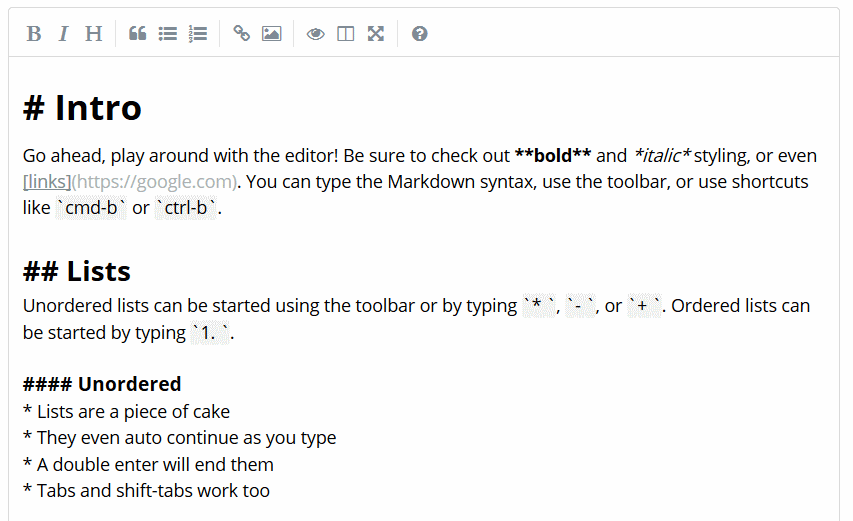KikiWWL は NASA-TLX による心的負荷の研究用ツールです。 文部科学省科学研究費特定領域研究「障害者・高齢者のコミュニケーション機能に関する基礎的研究」 (情報福祉の基礎) の研究班(キ)=通称 Kiki 班の活動として nishimotz が Delphi で実装しました。. 公開:2010-10-16 / 更新:2010-10-27. Working with Markdown. Note: You can author your README using Visual Studio Code. Here are some useful editor keyboard shortcuts: Split the editor (Cmd+ on macOS or Ctrl+ on Windows and Linux)Toggle preview (Shift+CMD+V on macOS or Shift+Ctrl+V on Windows and Linux)Press Ctrl+Space (Windows, Linux) or Cmd+Space (macOS) to see a list of Markdown snippets; For more information.
- DESCRIPTION
Catalyst::View::Markdown - Markdown View Class
Download google classroom app for mac. # use the helper to create your View

# add custom configration in View/MD.pm
# add include path configuration in MyApp.pm
# render view from lib/MyApp.pm or lib/MyApp::Controller::SomeController.pm
This is the Catalyst view class for Markdown. Your application should define a view class which is a subclass of this module. Throughout this manual it will be assumed that your application is named MyApp and you are creating a Markdown view named MD; these names are placeholders and should always be replaced with whatever name you've chosen for your application and your view. The easiest way to create a Markdown view class is through the myapp_create.pl script that is created along with the application: Most recent macos version.
This creates a MyApp::View::MD.pm module in the lib directory (again, replacing MyApp with the name of your application) which looks something like this:
Now you can modify your action handlers in the main application and/or controllers to forward to your view class. You might choose to do this in the end() method, for example, to automatically forward all actions to the Markdown view class.
But if you are using the standard auto-generated end action, you don't even need to do this!
This will Just Work. And it has the advantages that:
If you want to use a different view for a given request, just set << $c->stash->{current_view} >>. (See Catalyst's
$c->viewmethod for details.<< $c->res->redirect >> is handled by default. If you just forward to
View::MDin yourendroutine, you could break this by sending additional content.
See Catalyst::Action::RenderView for more details.
CONFIGURATION
There are a three different ways to configure your view class. The first way is to call the config() method in the view subclass. This happens when the module is first loaded.
You may also override the configuration provided in the view class by adding a 'View::MD' section to your application config.
This should generally be used to inject the include paths into the view to avoid the view trying to load the application to resolve paths.
You can also configure your view from within your config file if you're using Catalyst::Plugin::ConfigLoader. This should be reserved for deployment-specific concerns. For example:
might be used as part of a simple way to deploy different instances of the same application with different themes.
DYNAMIC INCLUDE_PATH
Stash Markdown Table Of Contents
Sometimes it is desirable to modify INCLUDE_PATH for your templates at run time.
If you need to add paths to the end of INCLUDE_PATH, there is an include_path() accessor available:
Note that if you use include_path() to add extra paths to INCLUDE_PATH, you MUST check for duplicate paths. Without such checking, the above code will add 'path' to INCLUDE_PATH at every request, causing a memory leak.
A safer approach is to use include_path() to overwrite the array of paths rather than adding to it. This eliminates both the need to perform duplicate checking and the chance of a memory leak:
RENDERING VIEWS
The view plugin renders the template specified in the markdown_filename item in the stash.
If a stash item isn't defined, then it instead uses the stringification of the action dispatched to (as defined by $c->action) in the above example, this would be message, but because the default is to append '.md', it would load root/message.md.
The output generated by the file is stored in $c->response->body.
CAPTURING FILE OUTPUT
If you wish to use the output of a Markdown file for some other purpose than displaying in the response, e.g. for sending an email, this is possible using Catalyst::Plugin::Email and the render method:
METHODS
new
The constructor for the Markdown view. Sets up the Markdown provider, and reads the application config.
process($c)
Renders the template specified in $c->stash->{markdown_filename} or $c->action (the private name of the matched action). Calls render to perform actual rendering. Output is stored in $c->response->body.
It is possible to forward to the process method of a Markdown view from inside Catalyst like this:
N.B. This is usually done automatically by Catalyst::Action::RenderView.
render($c, $md_filename)
Renders the given file and returns output. Throws a Template::Exception object upon error.
If $md_filename is a scalar reference, the value will be use as Markdown text instead of searching for a file - this allows Markdown to be easily stored in other systems, e.g. a database table.
To use the render method outside of your Catalyst app, just pass a undef context. This can be useful for tests, for instance.
config
This method allows your view subclass to pass additional settings to the Markdown configuration hash, or to set the options as below:
INCLUDE_PATH
The list of paths Markdown will look for files in. The first matching file will be used.
CLASS
Allows you to specify a custom class to use as the template class instead of Text::Markdown.
This is useful if you want to use your own subclasses of Markdown.
Stash Markdown 2019
HELPERS
The Catalyst::Helper::View::Markdown helper module is provided to create your view module. There are invoked by the myapp_create.pl script:
The Catalyst::Helper::View::Markdown module creates a basic Markdown view module.
Catalyst, Catalyst::Helper::View::Markdown, Template::Manual
Stash Markdown Book
Richard Wallman, wallmari@bossolutions.co.uk
This program is free software. You can redistribute it and/or modify it under the same terms as Perl itself.
To install Catalyst::View::Markdown, copy and paste the appropriate command in to your terminal.
Stash-markdown-viewer-plugin
For more information on module installation, please visit the detailed CPAN module installation guide.
